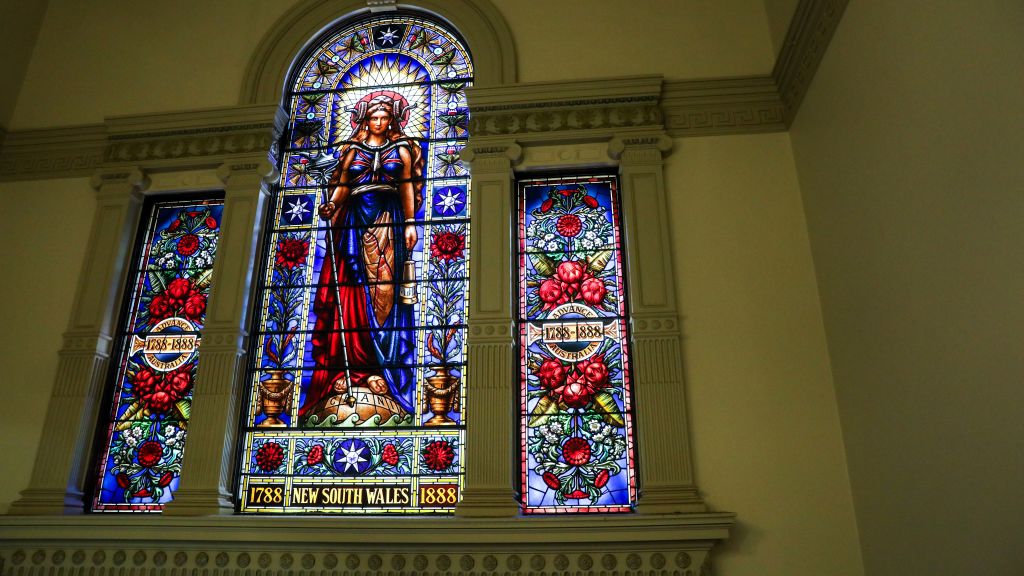Restoration of Sydney Town Hall’s historical stained glass windows will ensure an early Australian style of art is conserved for future generations.
Built to celebrate the centenary of 1888, Sydney Town Hall’s collection of stained glassed windows are considered some of the finest 19th century stained glass in Australia.
The stunning vestibule dome designed and manufactured in Australia in 1877 by John Falconer and Frederick Ashwin of Pitt Street, boasts the only example of a curved stained glass dome in Australia.
High above the double-storey space, the dome is decorated with 12 leadlight panels, each individually hand painted with a symbolic figure representing the four elements of Air, Earth, Fire and Water and eight female figures representing the virtues of Justice, Temperance, Industry, Prudence, Peace, Plenty, Trust and Liberty.
French artist Lucien Henry, who is renowned for leading the popularity of Australian style decorative arts, was commissioned to design the two inspirational stairwell window panels flanking Centennial Hall.
One window features the images of Captain Cook and the HMS Endeavour, and a female figure called ‘Oceania’, while on either side there are Australian wildflowers including waratahs, stenocarpus and lambertia. These panels are adorned with the words ‘Advance Australia’ and the dates of the centenary (1788-1888).
Lord Mayor Clover Moore said the Sydney Town Hall represented the civic heart of Sydney and the restoration will help retain the historical and architectural significance of the building for generations to come.
“Sydney Town Hall is a major landmark in the heart of the city, with its steps one of Sydney's best-used meeting points,” the Lord Mayor said.
“As one of the grandest historical buildings in Australia, and with its extensive examples of early Australian design and art, Sydney Town Hall’s cultural importance cannot be underestimated.
“The City is committed to conserving our rich history and looking after significant heritage buildings, including our town halls and the Queen Victoria Building.”
The works represent the final stage of a broader three-stage conservation project that began in 2012. Earlier conservation works were carried out on the Clock Tower and the east and north facades.
Other restoration work will include stonework repairs to the southern and western facades of the building, and repairs to the roof top, northern stairs and the structure of the vestibule dome.
The final construction stage is expected to start in early 2020 and take two to three years for the sandstone work, and four to five years for the stained glass windows.
City of Sydney curator Margaret Betteridge’s pictorial history book, Sydney Town Hall: The Building and its Collection, was published in 2008 by the City of Sydney, and contains a wealth of information about the building’s heritage, architecture and history.
“Sydney Town Hall contains many little known gems that are unique to any other building in Australia,” said Ms Betteridge.
“The elaborately decorated exterior and interior is significant and includes the first known use of Australian flora and fauna in its design.”
In 1867, the then Municipal Council of Sydney held a competition for the design of a ₤35,000 town hall building, which was won by a Tasmanian architect, J H Willson.
The following year, on 4 April, the Duke of Edinburgh, Prince Alfred, laid the foundation stone – cheered on by 2,000 well-wishers.
It was another 22 years before the building was officially opened at a ceremony in 1889, attended by several thousand distinguished guests, including Sir Henry Parkes and the then governor of NSW, Lord Carrington.
For media inquiries or images, contact the City of Sydney media team. Phone 0400 331 027 or email mediateam@cityofsydney.nsw.gov.au.
For interviews with Lord Mayor Clover Moore, contact Julia Lenton. Phone 0410 748 039 or email jlenton@cityofsydney.nsw.gov.au.
- Oceania stained glass window 2.41 MB
- Captain Cook stained glass 1.96 MB
- Sydney Town Hall dome 1.54 MB
